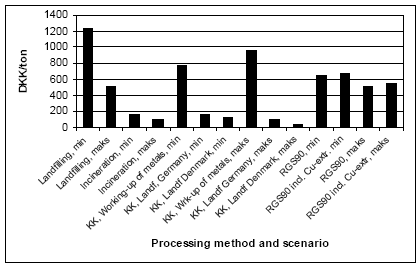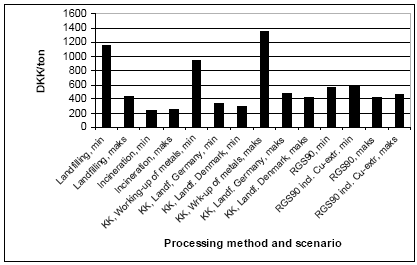Miljø- og samfundsøkonomisk analyse af indsamling og behandling af imprægneret affaldstræ
Summary and conclusions
Impregnated waste wood contains a series of chemicals, especially chromium, copper and arsenic, which can be hazardous to human and nature in concentrated quantities. In this analysis four methods of processing impregnated waste wood are considered: landfilling, incineration, gasification (by Kommunekemi) and an extraction process (by RGS90 Watech). The latter two have a larger element of recycling; hence they are both preferable to landfilling and incineration in the hierarchy of waste. A welfare economic analysis, in which both the economic as well as the environmental consequences are included, is used to compare these four methods. The result of the analysis is that incineration and gasification are the cheapest in a welfare economic perspective. The reason is that both methods produce heat and thereby displace other more polluting fuels.
Background and Purpose
The report is financed by the Danish Environmental Protection Agency, and is launched to provide answers as to how society can process impregnated waste wood in an optimal manner. The decision of how to dispose of waste is often taken on the basis of the hierarchy of waste. The hierarchy of waste means that recycling is weighted higher than incineration which, in turn, is weighted higher than landfilling. The advocacy of this principle is under debate, and the debate has intensified in Denmark because of the government’s Waste Strategy 2005 - 2008. Processing impregnated waste wood causes problems because it contains several polluting chemicals, including chromium, copper, and arsenic. The effects of these depend on the concentration in which humans or nature are exposed to them, but they range from locally irritant to toxic and carcinogenic. There are some positive environmental effects from processing impregnated waste wood, and these include recycling or that it can displace other more polluting fuels. The report examines the economic as well as the environmental consequences of the four methods of processing. The results are compared to the hierarchy of waste.
Investigation
The report was prepared by akf, an institute of local governmental studies in Denmark, in co-operation with FORCE Technology and the National Environmental Research Institute. The analysis used is a welfare economic analysis, which includes both the direct costs of processing the wood and the environmental consequences of the four methods. The analysis is “a clean sheet” analysis, that is, society has to choose between different methods and there is no history thus, prior decisions or investments are not included. Furthermore the results are conditioned on it being optimal for a long period of time. In the results, the total consumption of resources used by society for each method is compared.
Main Findings
Four methods of processing impregnated waste wood are compared including the advantages and disadvantages of each. The report finds that the quantity of impregnated waste wood is not a limiting factor for the individual method. The main findings of the comparisons are illustrated in Figure A. The figure shows the welfare economic costs of the four methods. The costs are calculated as the costs in DKK of processing one tonne of impregnated waste wood. The figure also contains some sensitivity analyses in order to provide more robust results.

Figure A: Welfare economic costs (DKK/tonne processed impregnated waste wood) for both min. and max. scenario (2004/2005-prices)
Of the four methods it can be seen that incineration and processing at Kommunekemi (excl. the working-up of metals) are the cheapest. The reason is that both processes use the heat generated by the process and thereby displace other more polluting fuels. In the figure it is also worth noticing that landfilling is quite expensive, and it neither recycles nor uses the energy in the wood. If one only looks at the direct costs of the processes, and does not try to estimate the value of the environmental consequences, the differences between the methods are smaller, as can be seen below in figure B.
Project Results
Impregnated wood is mainly in telegraph poles, sleepers and waste wood from public waste collections. The report divides the impregnated wood into two categories; the creosote-treated and the non-creosote-treated. The creosote-treated wood is burned in incineration plants in a process that does not impact the environment. The non-creosote-treated wood, however, impacts the environment and this must be dealt with during processing. Therefore, the report focuses solely on the non-creosote-treated wood when comparing the methods. This wood is mostly found in telegraph poles and waste wood from public collections, hence only wood from these sources is included.
The Four Technologies
We focus on four different technologies: landfilling, incineration, gasification (by Kommunekemi) and an extraction process (RGS90 Watech). When the wood is landfilled the energy is not used nor is it recycled. When incinerating, the energy is utilized, but there is no recycling. The methods of both Kommunekemi and RGS90 Watech utilize the energy and have an element of recycling; hence they are both ranked higher in the hierarchy of waste.
Minimum and maximum scenario
A forecast of the future quantity of impregnated wood estimates that the collection potential is not a limiting factor for the plants. But there is uncertainty about the quantity of the wood collected by the public schemes. Using samples of the quantity collected by these schemes suggests a minimum and maximum scenario. They are divided so that the maximum scenario provides the best economy for the plants. For landfilling this means a higher specific weight (kg/m³) in the maximum scenario. The difference for the other three methods is that the calorific value is higher in the maximum scenario.
Results
In the economic analysis illustrated in figure B, it can be seen that the difference between methods of processing is smaller than in figure A.

Figure B: Economic costs (DKK/tonne processed impregnated waste wood) for both min. and max. scenario (2004/2005-prices)
The difference between the two figures comes from the fact that the environmental consequences are only taken into account in the welfare analysis. The gasification and the incineration process improve their position by displacing other more polluting fuels. If it is assumed that the wood stemming from RGS90 Watech’s process is used to produce electricity or heat, it is not unrealistic that RGS90 Watech’s method would be competitive to incineration and gasification.
Including the environmental consequences of the methods is not easy. These environmental consequences are hard to value. In this report it is done according to the guidelines from the Danish Environmental Protection Agency (Møller et al. 2000). The potential long-term effects of leaking from landfills and the effects of heavy metals in slag and discharge water are not included in the report, although CO2, NOx, SO2, arsenic, dioxins, lead and other heavy metals are. To make the results as robust as possible several sensitivity analyses have been made, e.g. by changing the prices of the environmental effects, changing the rate of interest and assuming different transport costs. The results of these analyses are unambiguous in their ranking of the methods, but they obviously change the “distance” between the methods.
All in all the results do not give occasion for believing that the hierarchy of waste should be ignored when choosing the optimal method of processing impregnated waste wood.
Version 1.0 December 2007, © Miljøstyrelsen.